Nyheter
Nickel – Electrification may boost demand
Publicerad
6 år sedanden
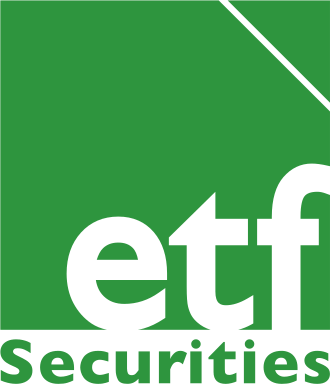
ETF Securities Commodities Research: Nickel – Electrification may boost demand
Highlights
- Nickel demand continues to outstrip supply.
- China’s shift to quality rather quantity may help nickel demand.
- Mine closures in Philippines constrain supply.
- Electrification of vehicles likely to continue to increase demand for nickel in battery usage.
Industrial metals as a group have staged a recovery since 2016, following five consecutive years of decline between 2011 and 2015. Although zinc is the only metal to have recovered its losses (in nominal, not real terms) since 2011, the Bloomberg Commodity index has rallied 65% since it hit a trough at the beginning of 2016. Nickel is the furthest away from 2011 prices, despite having risen 77% from its 2016 lows (source: Bloomberg). We believe that there is further potential for price gains amid structural changes in demand and supply.
Supply deficit
Mine supply has been unable to keep up with demand in recent years as miners cut back on investment during the period of weak prices. According to the UN International Nickel Study Group, primary nickel production will fall short of primary nickel usage by 148,000 tonnes (8.7% of demand) in 2018, marking the third consecutive year of a supply deficit in the metal.
Steel production forecast to grow
According to the International Stainless Steel Forum, steel production in 2017 grew by approximately 5% and is forecast to grow by around the same rate in 2018. Steel production accounts for the lion’s share of nickel consumption (67%).
China’s focus on environment
Nickel Pig Iron (NPI), a low-grade ferronickel primarily produced in China (for domestic usage), has experienced strong growth in recent decades as China’s urbanisation and construction boom has boosted demand for the metal. However, NPI production fell in 2016 and 2017 and China’s focus on better environmental outcomes could reduce its reliance on NPI in favour of higher quality nickel products. That shift will tighten the supply of higher grades of nickel ore. China’s demand for global nickel is likely to rise.
Philippine mine suspension still under review
When Philippine interim environment minister, Regina Lopez, failed to secure a permanent position, her decision to shutter 23 of the country’s 41 mines was widely thought to be reversed. The mines were closed due to environmental violations (see Metal supply to tighten as environmental concerns enforced). However, nine months on from her dismissal, the mines have not reopened. The Philippine government has not quite capitulated to miner lobbying power. Although it now allows open pit mining (which was banned by Lopez), it has appointed a team of 25 experts to assess mine closures with a report expected in Q1 2018. The Philippines was the largest nickel ore producer in 2016. Given the strength of evidence that there were environmental violations in the first review that led to the initial ban, we expect that a significant portion of mine supply will remain constrained after this second review.
Electrification of vehicles
Demand for electric vehicles is expected to grow substantially from a relatively low base. In 2016, the stock of electric vehicles was around 2 million (0.2% of total stock). The IEA forecast that by 2020 there will be between 9 and 20 million electric vehicles and by 2025 there will be 40-70 million vehicles. This growth in electric vehicles usage presents a structural change to the automobile market.
Notes: The RTS incorporates technology improvements in energy efficiency and modal choices that support the achievement of policies that have been announced or are under consideration. The 2DS is consistent with a 50% probability of limiting the expected global average temperature increase to 2°C. The B2DS falls within the Paris Agreement range of ambition, corresponding to an average increase in the global temperature by 1.75°C.
Electric vehicles – whether pure plugin or plugin-hybrid – rely on batteries. Currently the lithium-ion (Li-ion) battery is the most widely used technology for batteries. There are a number of different varieties of Li-ion batteries.
For cars, the nickel-manganese-cobalt (NMC) cathode is the most popular. The European Commission’s Joint Research Centre forecasts that NMC cathodes will grow more than other forms. By 2025, they expect NMC demand to rise from 40k tonnes in 2015 to 192k tonnes (a rise from 29% share to 48% share of the overall cathode active materials market for batteries).
Notes: Lithium Cobalt Oxide (LCO), Lithium Nickel Manganese Cobalt Oxide (NMC), Lithium Nickel Cobalt Aluminium Oxide (NCA), Lithium Manganese Oxide (LMO) and Lithium Iron Phosphate (LFP). With the exception of LCO, all these materials are currently used in automotive Li-ion battery cells.
Up until recently, the NMC cathode would use equal parts of nickel, manganese and cobalt, but the market is changing to a 8:1:1 ratio of the three metals (in favour of nickel). The reason for the transition is largely due to the relative scarcity of cobalt and potential supply disruptions to the metal. 60% of the world’s cobalt is mined out of the Democratic Republic of Congo (DRC). The country accounts for close to 50% of world known reserves of the metal. The DRC was embroiled in a civil war between 1998 and 2003, with an estimated death toll of 3.9 million (Source: International Rescue Committee). The current President’s mandate ran out in 2016 and his ability to cling onto power is fading. The risk of a serious political disruption is rising. The security of mineral resources from the DRC is weak and the association with human rights violations is becoming unpalatable for those sourcing the metal.
The structural shift toward greater electrical car usage combined with higher weighting of nickel in the Li-ion battery NMC cathodes looks likely to provide a boost for nickel demand in the coming decade.
For more information contact:
Catarina Donat Marques
ETF Securities (UK) Limited
T +44 20 7448 4386
E catarina.donatmarques@etfsecurities.com
Du kanske gillar
-


Blackrock listar tio nya iShares-ETFer på LSE
-


ETC Groups grundare säger att bitcoin återuppstår
-


Metallmagnaten säger att råvaruhandelsjätten låg bakom nickelbedrägeriet
-


Storbritannien förbjuder import av ryska diamanter
-


WisdomTree adderar litium och kobolt i sina fonder för övergångsmetaller
-


Rådgivares fokus skiftar mot råvaror
Nyheter
Bitcoin Warms up to Climate Goals and Ethereum’s Next Milestone: What Happened in Crypto This Week?
Publicerad
21 timmar sedanden
15 maj, 2024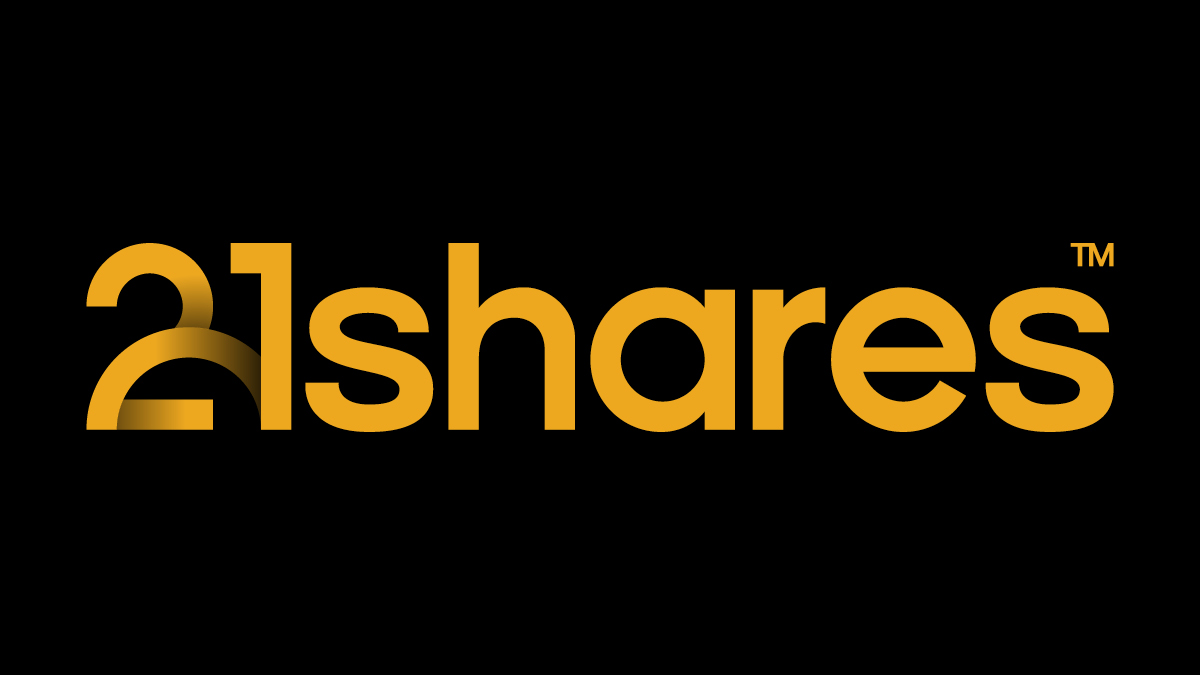
• European Economy Booms while Regulators Consider Adopting Crypto
• Bitcoin’s Growing Fundamentals and Institutionalization
• Ethereum’s Next Leap Forward: A Glimpse at the Upcoming Upgrade
European Economy Booms while Regulators Consider Adopting Crypto
Europe’s economy has exceeded expectations, with Germany’s gross domestic product (GDP) for Q1 2024 increasing by 0.2%, compared to the previous quarter’s reading of -0.5%. Additionally, France, Italy, and Spain are also seeing progress, picking up the bloc’s GDP from -0.1% to 0.3%. This is a good sign that Europe is on the right track away from a recession. Matching the positive outlook, regulators appear receptive to including new alternative assets within the EU’s most established regulatory framework.
Namely, the European Securities and Markets Authority (ESMA) is considering cryptoassets, among other asset classes like commodities and precious metals, in its Undertakings for Collective Investment in Transferable Securities (UCITS). Similar to mutual funds in the U.S., UCITS funds can be registered and sold in any country in the EU using unified regulatory and investor protection requirements. These funds are considered safe, well-regulated investments, hence their €12T market valuation and popularity among pension funds and risk-averse investors.
On May 7, ESMA invited investors and trade associations, among others, for a consultation to assess possible benefits and risks of UCITS gaining exposure to the selected 19 asset classes, having until August 7 to gather input. This is important since UCITS accounts for 75% of all collective retail investments in the EU. Thus, if the conclusions of this consultation are in favor of adopting crypto, it would attract an influx of investors and bring more regulated accessibility to this asset class. Moreover, although still under consultation, ESMA’s deliberation adds more credibility to crypto, considering the regulator’s renowned strict regulatory standards.
Further, the EU’s inflation is inching towards the 2% target, overshooting by only 0.4% in the past month, a level the U.S. is yet to achieve, with March’s inflation hitting 3.5%. Later today, a strong gauge for inflation is coming out, the Producer Price Index (PPI), measuring the change in the price of finished goods and services sold by producers. With the last consumer price index (CPI) disappointing, all eyes are on the CPI print coming out this Wednesday, along with data on retail sales. Although optimism seems to have checked out, a cooled inflation rate would recover investors’ appetite for risk-on assets like crypto, instigating more flows into Bitcoin spot ETFs, which have been especially quiet over the past week, as shown in Figure 1.
Figure 1: US Spot Bitcoin ETFs Flows

Source: Glassnode
Nevertheless, Bitcoin’s narrative has been growing beyond its primary use case as a store of value, with companies and governments alike leveraging Bitcoin mining to reduce their negative impact on the environment, ironically something Bitcoin is often scrutinized for.
Bitcoin’s Growing Fundamentals and Institutionalization
On May 7, Genesis Digital Assets and Argentina’s state-owned YPF Luz, the country’s largest producer of oil and gas with a ∼40% share in 2021, announced their opening of a Bitcoin mining facility. The data center takes ‘stranded gas,’ a byproduct of oil and gas production that would otherwise be flared and contribute to greenhouse gas emissions, to power the mining operation with the potential to reduce carbon dioxide equivalent emissions by 25-63%. Notably, 50 major oil and gas companies, representing over 40% of global petroleum production, signed the Oil and Gas Decarbonization Charter (OGDC), thereby committing to end gas flaring by 2030. The Argentinian project serves as a prime example of how companies can achieve the goals outlined in the OGDC, an approach likely to be replicated by others potentially using Bitcoin.
Aside from the obvious environmental benefits, projects like these actually strengthen Bitcoin’s network! More miners joining the fray means greater computing power, reflected by the growing hash rate in Figure 2. This results in a more secure network, as 51% attacks become more costly to execute successfully. The development comes at a crucial point in time, calming fears over miners exiting the network to cover costs, a dynamic often witnessed post-halving and one we explored in our Bitcoin Halving Report.
Figure 2 – Bitcoin Growing Hash Rate

Source: 21co on Dune
On a more familiar note, institutions continue to gobble up Bitcoin as an investment opportunity. The recent 13F filings mentioned last week revealed a growing appetite for Bitcoin as investment managers continue to disclose their U.S. equity holdings to the SEC. Quantitative trading firm Susquehanna holds over $1B in Bitcoin ETFs, with Boston-based hedge fund Bracebridge disclosing their $380M position too. Furthermore, in Japan, a weakened yen and government debt reaching 250% of GDP confirms sustained economic pressure, which has led early-stage investment firm Metaplanet to adopt Bitcoin as a strategic reserve. They have acquired over $7M since April, another testament to Bitcoin’s value proposition as a safe haven. The continuous adoption of Bitcoin is no surprise, given the accessibility of Bitcoin ETFs to traditional institutions through a regulated and familiar investment vehicle.
The positive Bitcoin sentiment is amplified by continuous innovation on the network itself. Bitcoin’s prime scaling solution, the Lightning Network, has taken a significant leap forward. By leveraging the Taproot Asset Upgrade, the Lightning Network successfully tested a protocol for issuing stablecoins directly on Bitcoin. This underscores the trend of Bitcoin’s growing use cases following the launch of Runes, which unlocked the ability to launch fungible tokens on Bitcoin. The recent surge in on-chain activity is reminiscent of the ERC-20 explosion in Ethereum’s early days, and stablecoins would truly unlock Bitcoin’s DeFi potential. They facilitate a wide range of transactions, shown below by Ethereum stablecoins amassing $3.8T in 2024 processed volume so far.
Figure 3 – Ethereum Stablecoin Volume
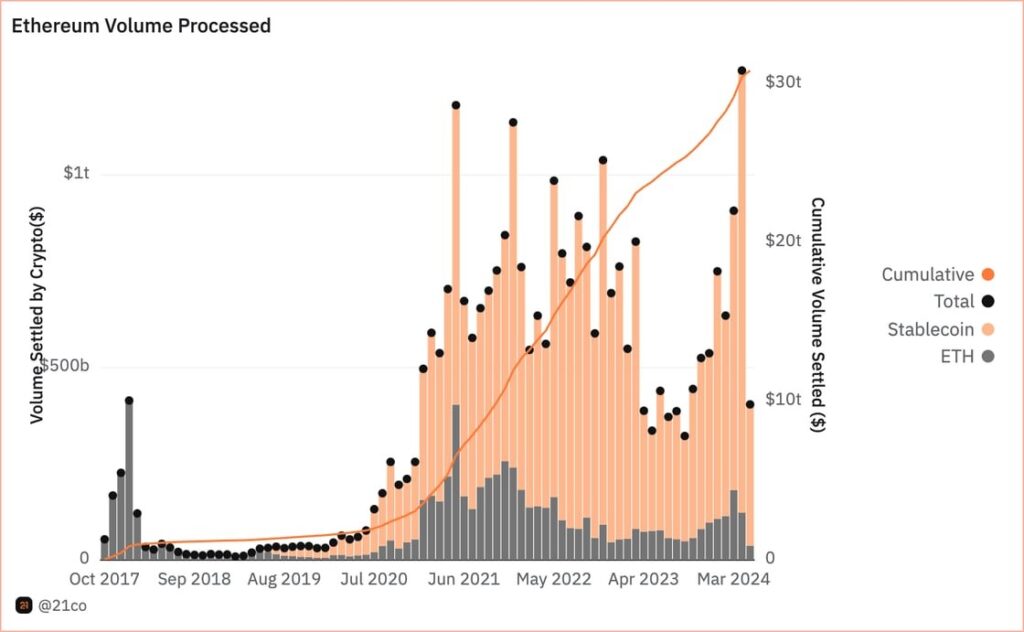
Source: 21co on Dune
While still in the early stages, this development would also significantly boost miner revenue, offering them a much-needed additional income stream through transaction fees, following the halving of block rewards last month. The potential of stablecoins on Bitcoin will be monitored going forward, as they have clear implications for the network’s potential on-chain footprint.
Ethereum’s Next Leap Forward: A Glimpse at the Upcoming Upgrade
More information is finally starting to come out regarding Ethereum’s next major upgrade, slated for late this year or early next year. Known as Pectra, the upgrade promises to introduce a range of enhancements aimed at bolstering the network’s stability and refining user experience. For example, the upgrade will raise the maximum stake per validator from 32 to 2,048 ETH, streamlining the management process for large validators who spread their stake across multiple wallets. Moreover, Pectra will tackle the problem of empty accounts, those with zero assets or funds, by removing them from the network. This action reduces the network’s state size, which effectively leads to lighter transaction processing.
Although the upgrade will incorporate various Ethereum Improvement Proposals (EIPs), one in particular stands out. Referred to as EIP 7702, Vitalik Buterin’s new proposal aims to expand upon the advancements made in Account Abstraction (AA) on Ethereum by refining certain concepts introduced in an earlier proposal, EIP 3074. As a quick recap, AA transforms users’ wallets, externally owned accounts (EOAs), into more sophisticated accounts resembling smart contracts, enhancing security, flexibility, and simplified user management. That said, EIP 7702 addresses some of EIP 3074 criticisms by steering clear of dependencies on EOA-specific functionalities. It aims to establish a versatile system capable of meeting the evolving needs of the Ethereum ecosystem while helping to reduce technical debt for the network
However, EIP 7702 proposes several other enhancements, including batched transactions, which could enhance transaction efficiency and even reduce fees by consolidating multiple user actions. Another exciting feature is the introduction of s sponsored transactions, which allow third-party applications to cover transaction fees for consumers, an ideal solution for onboarding new users. Finally, the upgrade could make users’ accounts resistant to threats from quantum computing. That said, with the proposal’s introduction of a new transaction type enabling EOAs to temporarily transition into smart accounts, concerns arise regarding the heightened risk of malicious actors’ ability to swiftly drain user wallets. Nevertheless, Vitalik’s proposal is intriguing as it charts a more pragmatic course toward realizing the AA vision. This is pivotal because it echoes our thesis at 21Shares that crypto won’t onboard millions of more users without providing them with an intuitive interface resembling the user-friendly experience they are familiar with across Web2.
Now, while Ethereum’s long-term prospects remain promising, its status as a deflationary network has come under threat in recent weeks, as seen below in Figure 3. This decline is primarily attributed to decreasing on-chain activity, which peaked at the end of March. Furthermore, the DenCun upgrade, implemented in March, significantly reduced the costs L2s incurred for storing their data on Ethereum by 90%.
Figure 4 – Ethereum’s Inflation
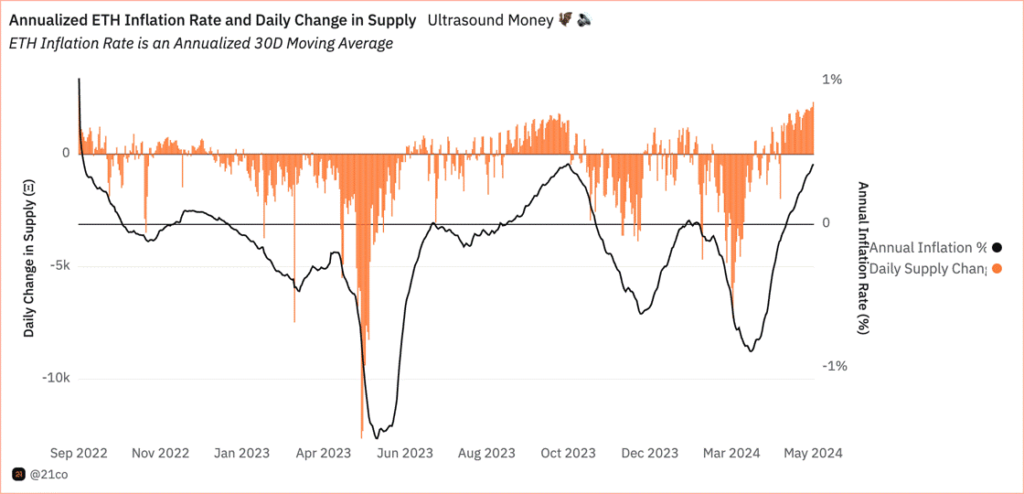
Source: 21co on Dune
It is worth noting that while it is currently more cost-effective for L2s to operate on Ethereum, these reduced costs will eventually onboard a larger user base. This will make it more feasible for applications, especially those requiring a high volume of interactions, to operate within the Ethereum ecosystem, which was previously economically unviable. A pivotal piece of evidence supporting this perspective is Arbitrum’s recent milestone, onboarding approximately 600K daily active users, as depicted in Figure 4. This likely influenced Securitize’s decision to propose deploying Blackrock’s BUIDL on Arbitrum, considering its position as the pioneering L2 platform with such a vibrant user base, alongside being the first L2 to process over $150B in swap volume on Uniswap, putting Arbitrum as the leading Ethereum scaling solution. Nevertheless, readers shouldn’t be wary, as we expect a broader spectrum of applications to arrive at the Ethereum network, helping to fill in the gap for Ethereum’s lost revenue while expanding the universe for what is possible within its ecosystem.
Figure 4 – Daily Active Users of Ethereum’s Leading Solutions

Source: GrowThePie
This Week’s Calendar
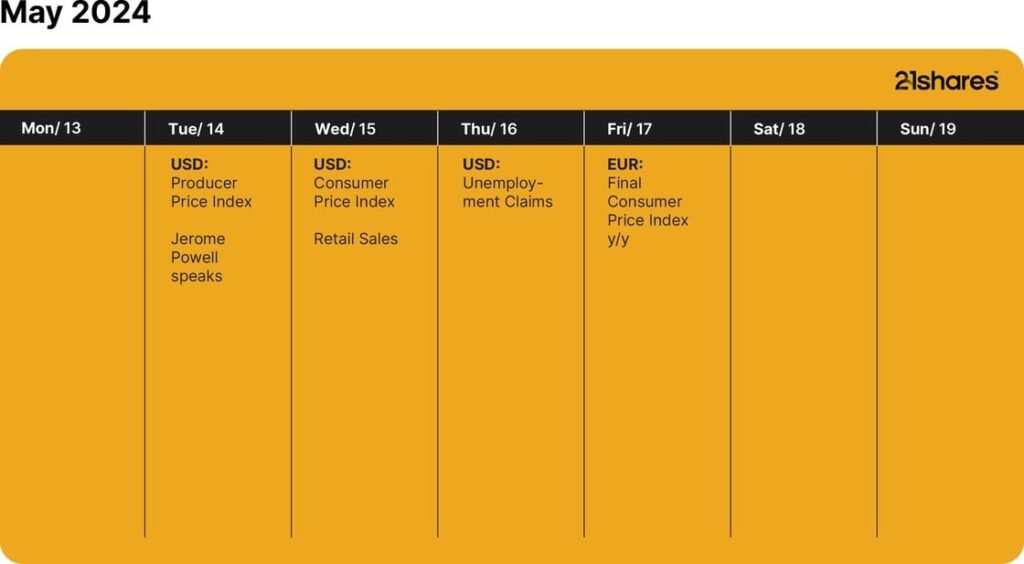
Source: Forex Factory, 21Shares
Research Newsletter
Each week the 21Shares Research team will publish our data-driven insights into the crypto asset world through this newsletter. Please direct any comments, questions, and words of feedback to research@21shares.com
Disclaimer
The information provided does not constitute a prospectus or other offering material and does not contain or constitute an offer to sell or a solicitation of any offer to buy securities in any jurisdiction. Some of the information published herein may contain forward-looking statements. Readers are cautioned that any such forward-looking statements are not guarantees of future performance and involve risks and uncertainties and that actual results may differ materially from those in the forward-looking statements as a result of various factors. The information contained herein may not be considered as economic, legal, tax or other advice and users are cautioned to base investment decisions or other decisions solely on the content hereof.
Nyheter
CRPA ETF investerar i företagsobligationer och återinvesterar utdelningen
Publicerad
22 timmar sedanden
15 maj, 2024
iShares Global Corporate Bond UCITS ETF USD (Acc) (CRPA ETF) investerar i företagsobligationer med fokus på World. ETF:n innehar hela utbudet av obligationsförfall. De underliggande obligationerna har Investment Grade-betyg. Ränteintäkterna (kupongerna) i fonden återinvesteras (ackumuleras).
Den totala kostnadskvoten uppgår till 0,20 % p.a. Fonden replikerar resultatet för det underliggande indexet genom att köpa ett urval av de mest relevanta indexbeståndsdelarna (samplingsteknik). iShares Global Corporate Bond UCITS ETF USD (Acc) har tillgångar på 116 miljoner GBP under förvaltning. ETF:en är äldre än 3 år och har sin hemvist i Irland.
Varför CRPA?
Diversifierad exponering mot globala företagsobligationer
Direktinvesteringar i företagsobligationer över sektorer (industri, allmännyttiga och finansiella företag)
Obligationsexponering med investeringsgrad
Investeringsmål
Fonden strävar efter att följa utvecklingen av ett index som består av företagsobligationer av investeringsklass från emittenter på tillväxtmarknader och utvecklade marknader.
Investeringsstrategi
Bloomberg Global Aggregate Corporate-index spårar företagsobligationer i amerikanska dollar utgivna av företag över hela världen. Alla löptider ingår. Betyg: Investment Grade.
Handla CRPA ETF
iShares Global Corporate Bond UCITS ETF USD (Acc) (CRPA ETF) är en europeisk börshandlad produkt som handlas på London Stock Exchange.
London Stock Exchange är en marknad som få svenska banker och nätmäklare erbjuder access till, men DEGIRO gör det.
Börsnoteringar
| Börs | Valuta | Kortnamn |
| gettex | EUR | SXRB |
| London Stock Exchange | USD | CRPA |
Största innehav
| Emittent | Vikt (%) |
| BANK OF AMERICA CORP | 1.83 |
| JPMORGAN CHASE & CO | 1.63 |
| GOLDMAN SACHS GROUP INC/THE | 1.29 |
| MORGAN STANLEY | 1.15 |
| CITIGROUP INC | 1.13 |
| WELLS FARGO & COMPANY | 1.12 |
| VERIZON COMMUNICATIONS INC | 0.97 |
| AT&T INC | 0.95 |
| APPLE INC | 0.84 |
| HSBC HOLDINGS PLC | 0.78 |
Innehav kan komma att förändras
Nyheter
Timely and concise insights on Bitcoin & Cryptoasset Markets
Publicerad
24 timmar sedanden
15 maj, 2024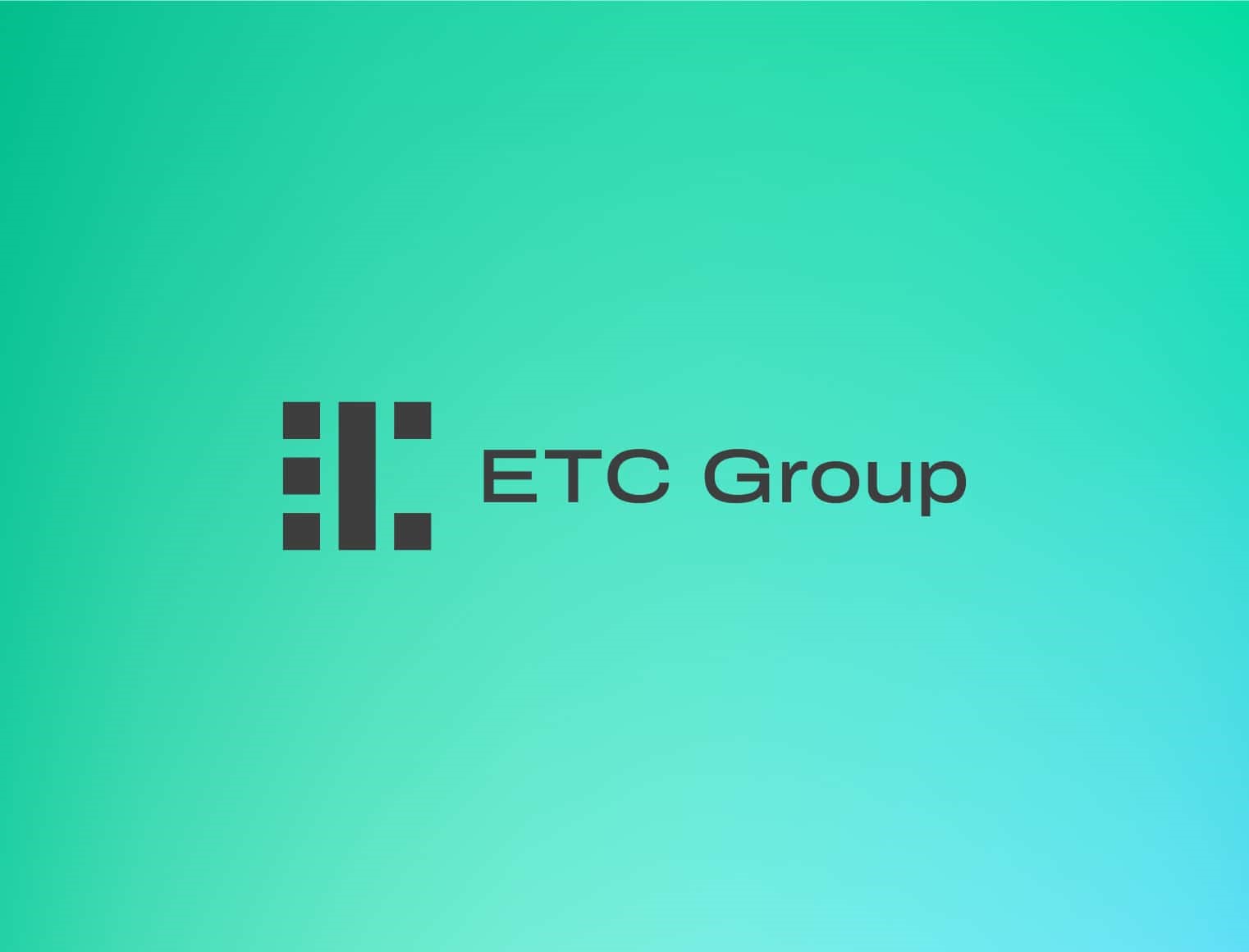
• Growing Mainstream Adoption of Digital Assets: Institutional investors and major asset managers are increasingly incorporating digital assets like Bitcoin into their portfolios, as evidenced by recent filings and the launch of Bitcoin ETFs in the U.S. Despite their current small market share, these investments reflect a broader trend towards mainstream acceptance
• Impact on Portfolio Performance: The inclusion of Bitcoin in portfolio optimizations, using strategies such as Maximum Sharpe Ratio and Risk Parity, has shown to improve the risk-adjusted returns compared to traditional portfolios. Portfolios optimized with Bitcoin not only offer higher returns for the additional risk taken but also present a wider range of efficient risk-return combinations
• Optimal Allocation Recommendations: Empirical studies suggest that even a small allocation to digital assets, specifically between 2% to 3% in broader asset mixes and up to 4% to 6% in more focused digital asset portfolios, significantly enhances portfolio performance without adversely impacting overall risk profiles
Gradually, then suddenly, as they say, digital assets are becoming mainstream.
The biggest asset managers in the world have launched spot Bitcoin ETFs in the US this year and adoption among institutional investors is rising rapidly.
Major financial institutions like Franklin Templeton themselves have just recently disclosed significant investments into Bitcoin ETFs via their latest 13F filings.
Institutional hedge funds that manage money for Ivy League university endowments have disclosed multi-million Dollar holdings. Stanford university’s Blyth Fund has recently disclosed that they hold around 7% allocation in Bitcoin ETFs.
Nonetheless, at the time of writing, US Bitcoin ETFs only account for approximately 0.6% of the overall size of the US ETF market based on data provided by ICI.
In Europe, Bitcoin ETPs also only comprise a tiny fraction of the 11 trn EUR UCITS market of only 0.05%, according to our calculations based on Bloomberg data.
In general, we expect the relative size of digital assets to increase further as even small allocations to digital assets are bound to increase portfolio risk-adjusted returns significantly as demonstrated in our latest deep dive on Bitcoin.
But what is the optimal allocation to Bitcoin and digital assets in general?
What is the optimal allocation to digital assets?
Most empirical portfolio studies usually look at how a classical 60/40 portfolio comprising of 60% allocation in stocks and 40% allocation in bonds responds to a gradual increase in digital asset allocation.
In our previous digital asset study, we did a similar exercise by investigating the effect of increases in digital asset allocation on overall portfolio risk and return metrics.
Since digital assets generally exhibit a higher risk-adjusted return (“Sharpe Ratio”) than other traditional asset classes, a marginal increase in allocation usually leads to an increase in overall portfolio risk-adjusted returns.
However, most institutional asset managers don’t employ a 60/40 portfolio in the first place because of high portfolio volatility and the dominance of the equity allocation for the whole portfolio’s risk-return profile.
In fact, most institutional asset managers in practice allocate based on optimized risk metrics such as portfolio Sharpe Ratio or portfolio volatility which is why we perform a similar exercise here.
In a first step, we looked at optimized multiasset portfolios comprising of global stocks (MSCI World AC), global bonds (Bloomberg Global Aggregate USD-hedged), and commodities (Bloomberg Commodity Index).
More specifically, we optimized these portfolios based on the following approaches:
• Minimum Variance/Volatility
• Maximum Sharpe Ratio
• Equal risk contribution (Risk parity)
The Minimum Variance approach tries to minimize the average portfolio volatility.
The Maximum Sharpe Ratio approach tries to maximize the ratio between average portfolio return (minus a risk-free return) and the corresponding average volatility. The Equal risk contribution or Risk Parity approach varies the respective portfolio weights until every asset has an identical relative contribution to the overall portfolio volatility.
In a second step, we added Bitcoin to the set of potential assets into the optimization. Our period of investigation (July 2010 – May 2024) was constrained by the fact that reliable market prices for Bitcoin only exist since 2010 as it is still a relatively young asset.
Here are the results for the different optimizations. The upper panel excludes Bitcoin while the lower panel includes Bitcoin in the optimization:

Several observations are in order:
Firstly, the minimum variance approach excludes Bitcoin completely since Bitcoin generally exhibits a higher level of volatility than the other assets.
Secondly, the maximum Sharpe Ratio approach excludes commodities in the traditional portfolio but includes Bitcoin in the new portfolio. The Bitcoin allocation is made largely at the expense of the stock allocation.
Lastly, the risk parity approach also includes Bitcoin at the expense of all other asset classes.
Furthermore, a comparison between the historical performances of the traditional portfolios that exclude Bitcoin and those that include Bitcoin reveals that the max Sharpe Ratio and the Risk Parity (ERC) portfolio were able to significantly outperform the Minimum Variance portfolio which didn’t allocate to Bitcoin at all.
It is also important to highlight that the Risk Parity portfolio with Bitcoin even exhibited a smaller maximum drawdown than the Minimum Variance portfolio without Bitcoin. In other words, the increase in portfolio volatility was largely due to an increase in positive upside volatility.
Moreover, investors are over-proportionately rewarded with higher returns for unit of additional risk as the risk-adjusted returns (“Sharpe Ratio”) increase significantly by adding Bitcoin.
The Sharpe Ratios for optimized portfolios with Bitcoin are even significantly higher than for optimized portfolios without Bitcoin.
In fact, by including Bitcoin and digital assets into their portfolio optimization, the universe of potential multiasset portfolios increases vastly.
Asset managers are not only enabled to provide investors with more efficient portfolios, i.e. higher risk-adjusted returns, but also provide investors with a much larger set of risk-return combinations compared to traditional portfolios that only include stocks, bonds, and commodities.
So far so good. What about other digital assets?
We also applied the same portfolio optimization approaches to a basket of the top 20 digital assets based on the MSCI Global Digital Assets Select 20 Capped Index.
–> The optimal % allocation is even higher in case of the Maximum Sharpe Ratio and Risk Parity portfolio optimization.
It is important to note that the period of investigation (November 2019 – May 2024) is much smaller due to the fact that younger digital assets within the top 20 digital assets like Solana or Ethereum have a smaller track record than Bitcoin.
All in all, the abovementioned results imply that even a small allocation to digital assets can have very positive effects on risk-adjusted returns without compromising the risk characteristics of the portfolios.
While highly risk-averse investors should probably avoid digital assets, the optimal allocation based on the Max Sharpe Ratio and Risk Parity approach appears to be between 2% and 3% for the full sample with bitcoin and between 4% and 6% for the smaller sample with a basket of the top 20 digital assets.
The results generally support our previous findings that we presented here.
Most portfolio optimization approaches also include digital assets within the optimal portfolio allocation which demonstrates that any modern portfolio approach that doesn’t include digital assets like Bitcoin is probably sub-optimal.
We recommend that agile asset managers familiarise themselves with this emerging asset class for the benefit of their clients and to remain competitive.
Bottom Line
• Growing Mainstream Adoption of Digital Assets: Institutional investors and major asset managers are increasingly incorporating digital assets like Bitcoin into their portfolios, as evidenced by recent filings and the launch of Bitcoin ETFs in the U.S. Despite their current small market share, these investments reflect a broader trend towards mainstream acceptance
• Impact on Portfolio Performance: The inclusion of Bitcoin in portfolio optimizations, using strategies such as Maximum Sharpe Ratio and Risk Parity, has shown to improve the risk-adjusted returns compared to traditional portfolios. Portfolios optimized with Bitcoin not only offer higher returns for the additional risk taken but also present a wider range of efficient risk-return combinations
• Optimal Allocation Recommendations: Empirical studies suggest that even a small allocation to digital assets, specifically between 2% to 3% in broader asset mixes and up to 4% to 6% in more focused digital asset portfolios, significantly enhances portfolio performance without adversely impacting overall risk profiles
To read our Crypto Market Compass in full, please click the button below:


Bitcoin Warms up to Climate Goals and Ethereum’s Next Milestone: What Happened in Crypto This Week?

CRPA ETF investerar i företagsobligationer och återinvesterar utdelningen

Timely and concise insights on Bitcoin & Cryptoasset Markets

Valour Inc. lanserar världens första avkastningsbärande Bitcoin (BTC) ETP

Virtune lanserar Virtune Staked Cardano ETP på Nasdaq Stockholm

ETFmarknaden i Europa firar sitt 24-årsjubileum med tillgångar på två biljoner USD

Vilken är den bästa fond som följer Nasdaq-100?

Några av de bästa guldfonderna

De mest populära börshandlade fonderna april 2024

Sveriges enda riktiga råvarufond har öppnat
Populära
-

 Nyheter4 veckor sedan
Nyheter4 veckor sedanETFmarknaden i Europa firar sitt 24-årsjubileum med tillgångar på två biljoner USD
-

 Nyheter3 veckor sedan
Nyheter3 veckor sedanVilken är den bästa fond som följer Nasdaq-100?
-

 Nyheter2 veckor sedan
Nyheter2 veckor sedanNågra av de bästa guldfonderna
-

 Nyheter2 veckor sedan
Nyheter2 veckor sedanDe mest populära börshandlade fonderna april 2024
-
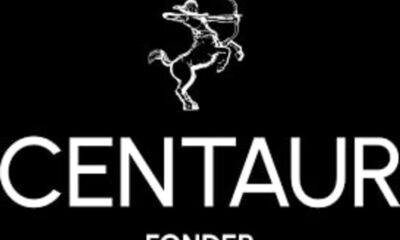
 Nyheter4 dagar sedan
Nyheter4 dagar sedanSveriges enda riktiga råvarufond har öppnat
-

 Nyheter1 vecka sedan
Nyheter1 vecka sedanEndast en tredjedel av brittiska privatinvesterare har hört talas om ansvarsfulla investeringar eller ESG
-

 Nyheter3 veckor sedan
Nyheter3 veckor sedanU.S. Global Investors tar över HANetf Travel
-
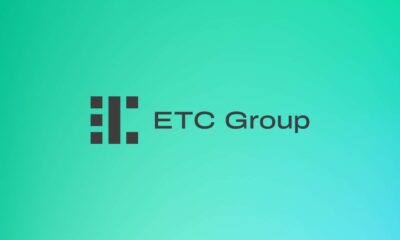
 Nyheter2 veckor sedan
Nyheter2 veckor sedanBTC1 ETP spårar priset på kryptovalutan Bitcoin



